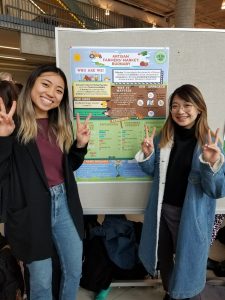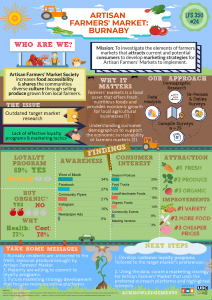“Start strong, stay strong, and finish strong by always remembering why you’re doing it in the first place.” -Ralph Marsto”
From an initial curiosity, to newfound friendships and a final goodbye to the Artisan Farmers’ Market project, being a part of LFS 350 was an exciting journey from start to end. We’ve learned a lot along the way and ran into numerous unpredictable barriers that required both strategic planning and teamwork to resolve. In this final segment of the project, we collected our findings and shared them with the public. Standing in front of strangers was an emotional continuum of nerves and anxiety to a fluttering eagerness to prove ourselves. The only way to describe the sentiment is “ex-yikes-ting!”
WHAT?
As a group, we allocated a lot of our time and thought to come to a consensus for which information will be placed into our infographic. At first, analyzing the data took a long process as we had a large sample size and had a numerous number of survey questions. We felt overwhelmed by the amount of data and were uncertain how to connect the dots to make a logical summary.
 We then took a step back, and worked together to apply statistical analysis concepts learned from courses we took in UBC to summarize our findings. We discovered that the source of food and produce from the artisan market was the universal attraction from both current and potential attendees. With a clearer view of our results, we were able to discuss and were able to agree on the most significant information that is relevant to our project goals – help shed some light for our community partner about the demographic, the wants of existing/potential customers for the future, and a new direction towards advertising the Artisan Farmers’ Market.
We then took a step back, and worked together to apply statistical analysis concepts learned from courses we took in UBC to summarize our findings. We discovered that the source of food and produce from the artisan market was the universal attraction from both current and potential attendees. With a clearer view of our results, we were able to discuss and were able to agree on the most significant information that is relevant to our project goals – help shed some light for our community partner about the demographic, the wants of existing/potential customers for the future, and a new direction towards advertising the Artisan Farmers’ Market.
Feeling relieved, we began constructing our infographic. In the infographic, we all had agreed on three important take home messages: 1) fresh, seasonal produce attract the Burnaby residents the most, 2) the majority of the residents want loyalty programs, and 3) a shift towards online platforms is needed for future marketing strategies to increase awareness of the Burnaby Artisan Farmers’ Market.
SO WHAT?

Despite feelings of confusion in our process of synthesizing our data, we knew the cycle of uncertainty fell hand in hand with resolution. It was important for our group to reiterate that “without a certain amount of anxiety and risk, there’s a limit to how much learning occurs” (Shulman, 2005, p. 18). As future professionals, we have come to appreciate uncertainty from the countless ambiguities we have encountered throughout this project and realized that the challenges can be overcome if the entire group acts resolute. We collaborated and tabulated the results. At first, the results appeared to be scattered and insignificant, but we were able to compile the information into several tables.
At this point, we faced the issue of deciding what information was the most important. We initially thought to work on the analysis as individuals and regroup on a future date. However, group collaboration leads to more complex and deeper analysis than what an individual would develop (Napier & Gershenfeld, 2004). With the vast amount of data, it would be difficult to conclude anything if we were not a collective group. Thus, our group assembled together and faced an encumbering amount of time in distinguishing the most important data. In the end, we were able to narrow our findings and highlight the points that we thought had patterns that produced powerful implications.
NOW WHAT?

Now that we have finished our infographic presentation our group feels that we have come a long way from where we started. Our hard work and motivation has paid off and we are very proud of all the accomplishments we have achieved up to date. The final poster presentation was an unforgettable experience that our group feels has brought us closer together. Now we are going to work on our final report and reflect on our journey through LFS 350.

The results of our research indicate a couple of take home messages that we strongly believe are important for the work of future groups who will be working with Burnaby Artisan Farmers’ Market. Firstly, the results of our survey indicate that Burnaby residents are attracted to the fresh, seasonal produce brought by Artisan Farmers’ Market. Secondly, the majority of residents are willing to commit to loyalty programs which is a potential promotional strategy for Burnaby Artisan Farmers’ Market to attract new potential customers. Our research on previous literature on loyalty programs propose that customer’s perspective on the business’s reputation greatly increases (Stathopoulou & Balabanis, 2016). This is because customers feel a sense of value and appreciation by the operation which will cause them to likely support the business, develop a mutually beneficial relationship, and share it to others as well (Stathopoulou & Balabanis, 2016). Thirdly, most residents heard about community events from online platforms, which indicates that Burnaby Artisan Farmers’ Markets should include future marketing strategy development which focuses more on online platforms.
From these take home messages, we have determined 2 future steps that can be taken for the next upcoming group. The first one is to develop and conduct a feasibility study on a potential customer loyalty program tailored to Burnaby Artisan Farmers’ Markets target market preferences. Next, using the data we have collected this term to curate a marketing strategy for Artisan Farmers’ Market that uses the preferred outreach platforms and highlighted interests. We hope the upcoming group will consider these potential next steps.
CONCLUSION

In this final chapter, all members have contributed their fair share of time, ideas and laughter in creating this blog. The skills gained from these experiences will carry us through our unique, undetermined and prospective goals. Artisans Farmers Market Society will also carry on the legacy of Group 24’s work as the findings will be shared among summer interns. The closure of this journey marks the beginning of another!
References
Stathopoulou, A. & Balabanis, G. (2016). The effects of loyalty programs on customer satisfaction, trust, and loyalty toward high-and low- end fashion retailers. Journal of Business Research, 69(12), 5801-5808.
Napier, R., & Gershenfeld, M. K. (2004). Groups: Theory and experience (7th ed.). Boston: Houghton Mifflin.
Shulman, L. S. (2005). Pedagogies of uncertainty. Liberal Education, 91(2), 18–25. Retrieved from http://files.eric.ed.gov/fulltext/EJ697350.pdf
